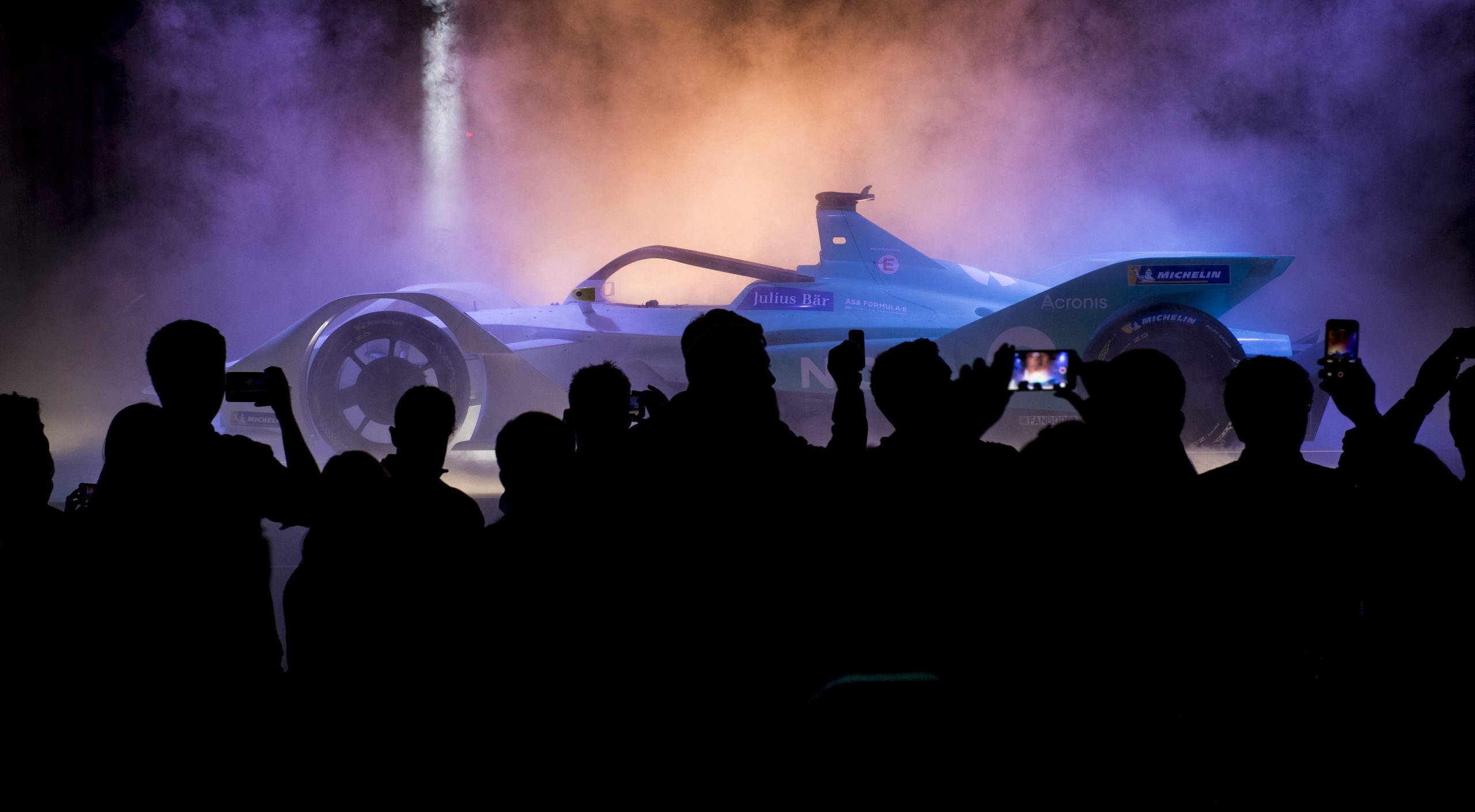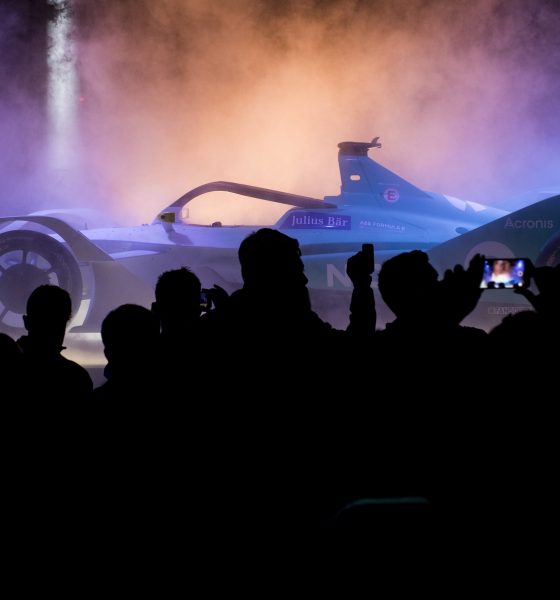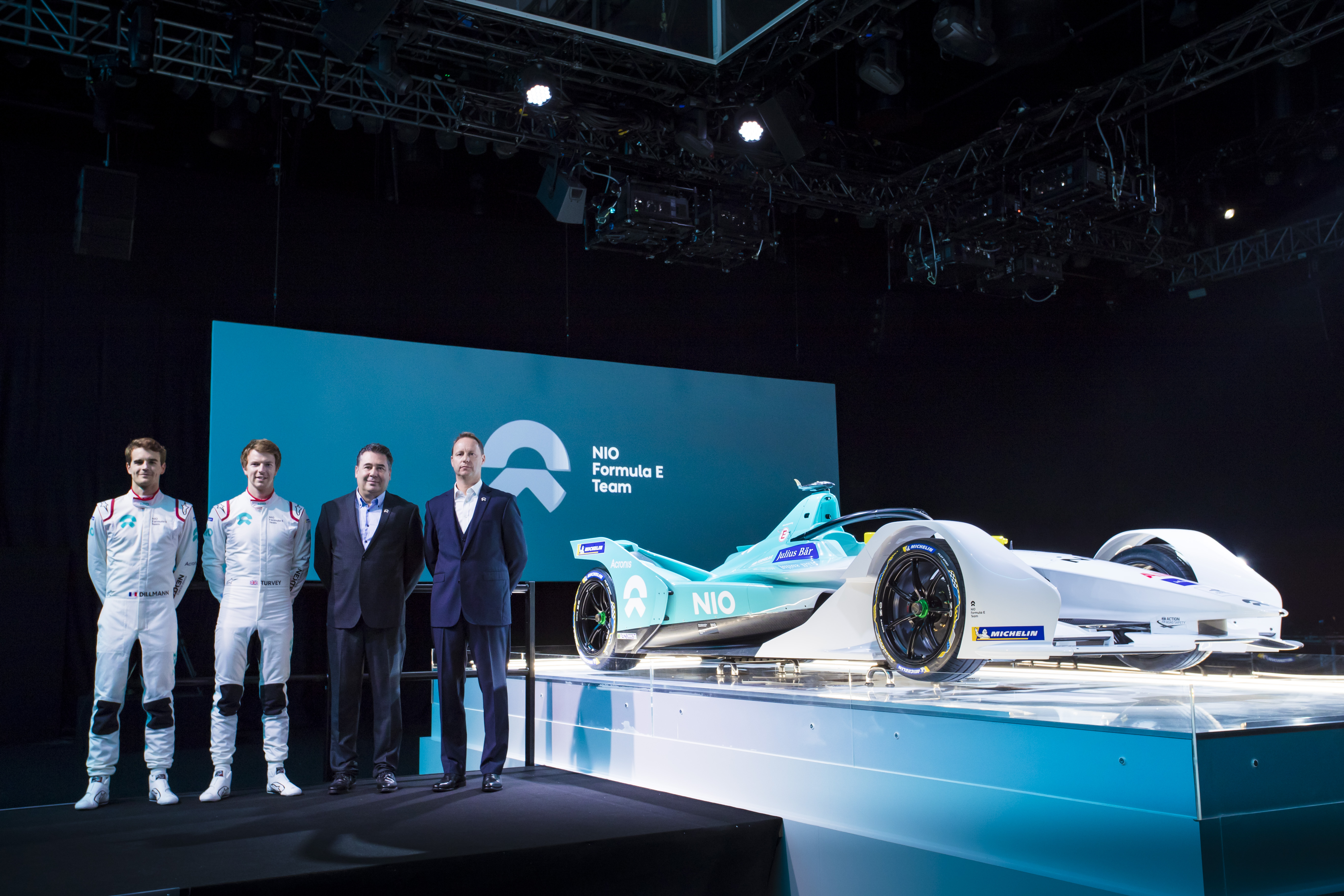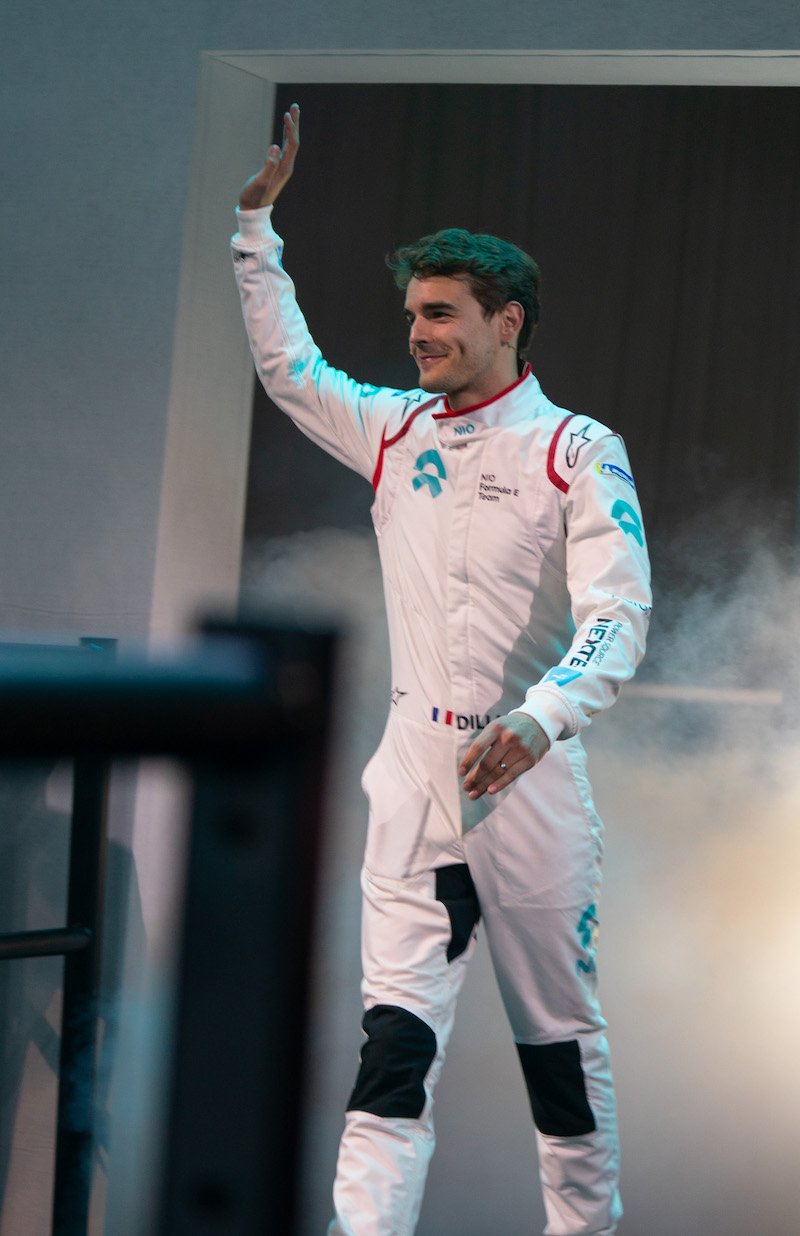

Investor's Corner
NIO’s new Formula E race car represents a turning point for the EV industry
At a flashy unveiling in East London on Monday night, NIO, the Chinese-based electric vehicle startup, unveiled their Gen2 Formula E car for Season 5 of the all-electric racing series. The extravagant fanfare wasn’t unwarranted, as the new car marks a historic point for the Formula E racing series and, more broadly, electric cars in general.
Up until this point, Formula E has been an exciting sporting event that, despite its best efforts, has struggled to overcome one of the longtime disadvantages of electric vehicles: range. This season, range anxiety is taking a back seat as battery improvements move the series forward. Advancements in the battery cells and the overall pack technology have allowed the cars to run the entire 45-minute race on a single charge. In prior seasons, each driver swapped into a second fully charged vehicle mid-race. The battery capacity has doubled, from 26 kWh to 54 kWh, while maintaining nearly the same size and weight.

The new vehicles will not only aide in the teams’ performance on the track but will also serve as a testbed for NIO’s most advanced technologies. “We are working on the cutting edge, whatever we learn here, may go down into the NIO production cars. Currently, the components we use are too expensive, but that’s a matter of time. The actual software that we use to program the inverter and everything that can all be used in the future,” said Paul Fickers, Performance Program Engineering Director at NIO.
The new technological advancements signify a much larger change in the entire EV industry: the impending dominance over internal-combustion engines. Allowing companies to go head-to-head, on a technological and skill-based level, by leaving range concerns behind and upping the maximum power output in the cars, will heat up competition between the teams to a truly exciting level.
With nearly all the teams entering or nearing production of their own electric roadcars, Season 5 of Formula E will be the most important yet. NIO began production of their first vehicle earlier this year in China, Audi announcing the e-Tron, Jaguar’s brand new i-Pace, Nissan’s long-time Leaf, and BMW’s i-Series. NIO’s Fickers told Teslarati that he especially believes NIO’s motor and inverter will best the competition.

Outside of technological changes to the vehicles, NIO is switching up their driver roster by adding Tom Dillmann to the team, joining long-time NIO driver, Oliver Turvey. Dillmann tells Teslarati that the driving experience of a Formula E vehicle is like no other, “I don’t compare it to a normal single seater, I just see it as Formula E. It is 900kg, it has a driver, this amount of power, different tires. Formula E for me is separate.”
Dillmann also highlighted the increased power on the new generation vehicle, with peak power rising from 200 kW to 250 kW. “On the tracks we are racing on, very narrow, twisty, it’s fast,” Dillmann noted, going on to state the power capacity boost will be especially noticeable in the qualifying races (when speed is the number one objective), “it’s going to be fast.”
In addition to a new vehicle and driver, NIO added Switzerland-based, cybersecurity firm Acronis as a long-term partner. The company will also be providing NIO with technology services.
In September, NIO listed on the New York Stock Exchange and became the second all-electric automaker to go public, after Tesla in 2010. With over 6,000 employees across the world, NIO is making a large bet on the world’s largest electric vehicle market in China.
While the Formula E races do help the company’s branding, they are looking to eventually bring the cutting-edge technology into their production vehicles, the NIO ES8 and ES6 (both crossovers). The vehicles have prices ranging from $55,000-$65,000, far less than Tesla’s Model X, which costs more than double that in China.
While only time will tell if NIO can meet their sales targets in China, we will be able to see NIO’s racing technology in action shortly. Formula E’s first race of Season 5 is being held in Ad Diriyah, Saudi Arabia on December 15th. With larger batteries and more powerful motors, the new season will surely be the most exciting yet.

Investor's Corner
Tesla stock closes at all-time high on heels of Robotaxi progress

Tesla stock (NASDAQ: TSLA) closed at an all-time high on Tuesday, jumping over 3 percent during the day and finishing at $489.88.
The price beats the previous record close, which was $479.86.
Shares have had a crazy year, dipping more than 40 percent from the start of the year. The stock then started to recover once again around late April, when its price started to climb back up from the low $200 level.
This week, Tesla started to climb toward its highest levels ever, as it was revealed on Sunday that the company was testing driverless Robotaxis in Austin. The spike in value pushed the company’s valuation to $1.63 trillion.
Tesla Robotaxi goes driverless as Musk confirms Safety Monitor removal testing
It is the seventh-most valuable company on the market currently, trailing Nvidia, Apple, Alphabet (Google), Microsoft, Amazon, and Meta.
Shares closed up $14.57 today, up over 3 percent.
The stock has gone through a lot this year, as previously mentioned. Shares tumbled in Q1 due to CEO Elon Musk’s involvement with the Department of Government Efficiency (DOGE), which pulled his attention away from his companies and left a major overhang on their valuations.
However, things started to rebound halfway through the year, and as the government started to phase out the $7,500 tax credit, demand spiked as consumers tried to take advantage of it.
Q3 deliveries were the highest in company history, and Tesla responded to the loss of the tax credit with the launch of the Model 3 and Model Y Standard.
Additionally, analysts have announced high expectations this week for the company on Wall Street as Robotaxi continues to be the focus. With autonomy within Tesla’s sights, things are moving in the direction of Robotaxi being a major catalyst for growth on the Street in the coming year.
Elon Musk
Tesla needs to come through on this one Robotaxi metric, analyst says
“We think the key focus from here will be how fast Tesla can scale driverless operations (including if Tesla’s approach to software/hardware allows it to scale significantly faster than competitors, as the company has argued), and on profitability.”

Tesla needs to come through on this one Robotaxi metric, Mark Delaney of Goldman Sachs says.
Tesla is in the process of rolling out its Robotaxi platform to areas outside of Austin and the California Bay Area. It has plans to launch in five additional cities, including Houston, Dallas, Miami, Las Vegas, and Phoenix.
However, the company’s expansion is not what the focus needs to be, according to Delaney. It’s the speed of deployment.
The analyst said:
“We think the key focus from here will be how fast Tesla can scale driverless operations (including if Tesla’s approach to software/hardware allows it to scale significantly faster than competitors, as the company has argued), and on profitability.”
Profitability will come as the Robotaxi fleet expands. Making that money will be dependent on when Tesla can initiate rides in more areas, giving more customers access to the program.
There are some additional things that the company needs to make happen ahead of the major Robotaxi expansion, one of those things is launching driverless rides in Austin, the first city in which it launched the program.
This week, Tesla started testing driverless Robotaxi rides in Austin, as two different Model Y units were spotted with no occupants, a huge step in the company’s plans for the ride-sharing platform.
Tesla Robotaxi goes driverless as Musk confirms Safety Monitor removal testing
CEO Elon Musk has been hoping to remove Safety Monitors from Robotaxis in Austin for several months, first mentioning the plan to have them out by the end of 2025 in September. He confirmed on Sunday that Tesla had officially removed vehicle occupants and started testing truly unsupervised rides.
Although Safety Monitors in Austin have been sitting in the passenger’s seat, they have still had the ability to override things in case of an emergency. After all, the ultimate goal was safety and avoiding any accidents or injuries.
Goldman Sachs reiterated its ‘Neutral’ rating and its $400 price target. Delaney said, “Tesla is making progress with its autonomous technology,” and recent developments make it evident that this is true.
Investor's Corner
Tesla gets bold Robotaxi prediction from Wall Street firm
Last week, Andrew Percoco took over Tesla analysis for Morgan Stanley from Adam Jonas, who covered the stock for years. Percoco seems to be less optimistic and bullish on Tesla shares, while still being fair and balanced in his analysis.

Tesla (NASDAQ: TSLA) received a bold Robotaxi prediction from Morgan Stanley, which anticipates a dramatic increase in the size of the company’s autonomous ride-hailing suite in the coming years.
Last week, Andrew Percoco took over Tesla analysis for Morgan Stanley from Adam Jonas, who covered the stock for years. Percoco seems to be less optimistic and bullish on Tesla shares, while still being fair and balanced in his analysis.
Percoco dug into the Robotaxi fleet and its expansion in the coming years in his latest note, released on Tuesday. The firm expects Tesla to increase the Robotaxi fleet size to 1,000 vehicles in 2026. However, that’s small-scale compared to what they expect from Tesla in a decade.
Tesla expands Robotaxi app access once again, this time on a global scale
By 2035, Morgan Stanley believes there will be one million Robotaxis on the road across multiple cities, a major jump and a considerable fleet size. We assume this means the fleet of vehicles Tesla will operate internally, and not including passenger-owned vehicles that could be added through software updates.
He also listed three specific catalysts that investors should pay attention to, as these will represent the company being on track to achieve its Robotaxi dreams:
- Opening Robotaxi to the public without a Safety Monitor. Timing is unclear, but it appears that Tesla is getting closer by the day.
- Improvement in safety metrics without the Safety Monitor. Tesla’s ability to improve its safety metrics as it scales miles driven without the Safety Monitor is imperative as it looks to scale in new states and cities in 2026.
- Cybercab start of production, targeted for April 2026. Tesla’s Cybercab is a purpose-built vehicle (no steering wheel or pedals, only two seats) that is expected to be produced through its state-of-the-art unboxed manufacturing process, offering further cost reductions and thus accelerating adoption over time.
Robotaxi stands to be one of Tesla’s most significant revenue contributors, especially as the company plans to continue expanding its ride-hailing service across the world in the coming years.
Its current deployment strategy is controlled and conservative to avoid any drastic and potentially program-ruining incidents.
So far, the program, which is active in Austin and the California Bay Area, has been widely successful.








